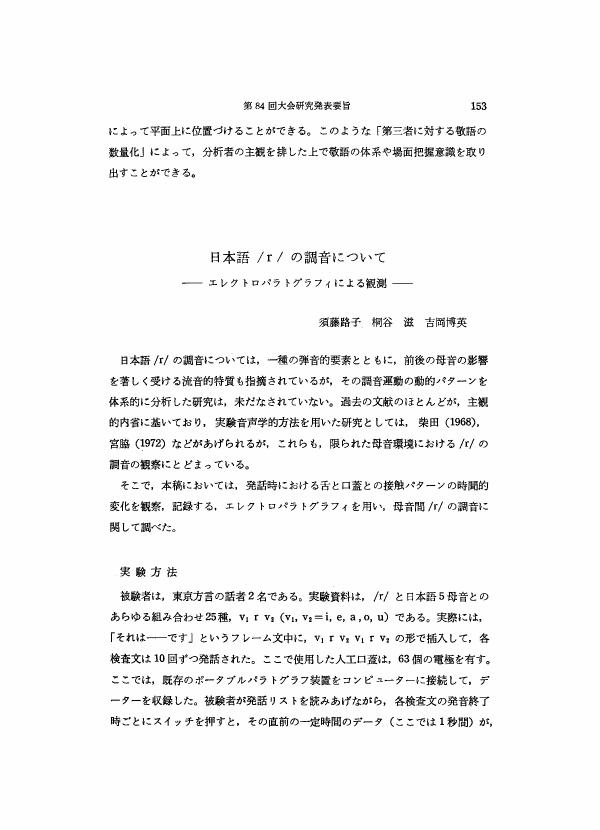4 0 0 0 OA 幼児・児童期における言語音知覚の発達的変化
- 著者
- 吉田 桂子 桐谷 滋
- 出版者
- 心理学評論刊行会
- 雑誌
- 心理学評論 (ISSN:03861058)
- 巻号頁・発行日
- vol.49, no.1, pp.215-225, 2006 (Released:2019-04-12)
2 0 0 0 OA 東京方言と近畿方言における母音の無声化の比較
- 著者
- 藤本 雅子 桐谷 滋
- 出版者
- 日本音声学会
- 雑誌
- 音声研究 (ISSN:13428675)
- 巻号頁・発行日
- vol.7, no.1, pp.58-69, 2003-04-30 (Released:2017-08-31)
- 被引用文献数
- 1
Japanese vowel devoicing is claimed to be less frequent in the Kinki dialect than in the Tokyo dialect (standard Japanese). In the present paper, frequency of vowel devoicing of /i/ in the non-sense /CiCe/ words is compared among Kinki- and Tokyo dialect speakers. The results indicated that, within pitch accent and speech rate groupings, some of the Kinki dialect speakers showed devoicing rates similar to that of the Tokyo dialect speakers. It was also confirmed that the devoicing rate for some Kinki dialect speakers was significantly less than that for Tokyo speakers. For Tokyo and Kinki speakers who had a high rate of devoicing, variation in rate of devoicing due to consonantal environment was 1) highly frequent (almost without exception) when a stop or an affricate was at least on one side, 2) less frequent (seemingly random) when fricatives were on both sides, and 3) infrequent (seemingly random) when there was a following /h/. A similar tendency was found for the Kinki speakers with a smaller rate of devoicing. The present results suggest that devoicing phenomena may be complex, occurring not only at higher (phonological) levels but also at the lower (phonetic) level.
2 0 0 0 日本語社会における言語習得と教育方策に関する総合的研究
交付金により、研究会合を重ねるとともに、平成5年10月22日(金)10時〜15時10分広島市中区中電大ホールにて「新しい日本語社会」「日本語習得の基盤を考える」と題して公開講演とシンポジウムを開催した。全国から多数の参会者があって、盛会に行われた。シンポジウムではメンバーの江川清・土岐哲・佐藤亮一・吉田則夫・真田信治の各氏とNHKの西橋アナウンサーに登壇いただいた。「日本語の習得と話言葉」のテーマの下、それぞれの立場からの提言と討議が行われた。午後から演題「日本語習得の基盤と社会言語学」井上史雄、演題「日本語の習得基盤と音声言語情報処理」桐谷滋各氏の講演があった。その成果を受けて、研究課題「国際化する日本語社会における音声言語の実態とその教育に関する総合的研究」により平成6年度総合研究(A)の申請をした。その内容はつぎの通りである。(1)国際化の進行している日本語社会における音声言語の実態を把握し、有効な教育方策を提案すること。(2)言語理論並びに高度情報処理技術等により、日本語社会における音声言語の教育に効果的な科学的方法を導入すること。この研究目的を、次の6事項に絞って期間内に達成する。A【.encircled1.】日本語社会における音声言語の多様性と標準、【.encircled2.】日本語社会における談話行動の習得過程、B【.encircled1.】日本語教育における学習活動が音声言語の習得に及ぼす効果、【.encircled2.】日本語社会における帰国子女・外国人子弟等の音声言語の習得、C【.encircled1.】日本語社会における音声言語の習得支援システムの開発、【.encircled2.】日本語社会における音声言語の教育用データーベース今年度の成果として、公開シンポジウムと公開講演を冊子にまとめ、研究機関や日本語教育関係機関等に配布した。
- 著者
- 鄭 恩禎 桐谷 滋
- 出版者
- 日本音声学会
- 雑誌
- 音声研究 (ISSN:13428675)
- 巻号頁・発行日
- vol.2, no.2, pp.64-70, 1998-08-30 (Released:2017-08-31)
In this paper, I show that pitch patterns influence native speakers of Korean in their perception of voiced and voiceless sounds in Japanese. It is shown that speakers of Korean, a language which does not have the contrast between voiced and voiceless sounds, rely on the difference of the pitch patterns rather than the voicing sounds. More specifically: 1. It was confirmed that, roughly speaking, higher pitch occurs in association with voiceless sounds, while lower pitch occurs in association with voiced sounds. 2. It was confirmed that Korean speakers have little problem perceiving voiceless sounds when they are accompanied by a clear high pitch, and voiced sounds when they are accompanied by a clear low pitch. In other cases, the rate of perception errors was high. 3. In a follow-up experiment, the pitch pattern of voiced sounds was substituted with that of their voiceless counterparts and that of voiceless sounds with that of their voiced counterparts. The results showed that Korean speakers are apt to perceive voiceless sounds as voiced when the accompanying pitch is low, while they tend to perceive voiced sounds as voiceless when the accompanying pitch is high. Japanese speakers showed the same tendency, but with a lower rate of errors in perception.
1 0 0 0 OA 麻痺性構音障害における発音動態の研究
- 著者
- 癖瀬 肇 桐谷 滋 吉岡 博英 沢島 政行 牛島 達次郎
- 出版者
- The Oto-Rhino-Laryngological Society of Japan, Inc.
- 雑誌
- 日本耳鼻咽喉科学会会報 (ISSN:00306622)
- 巻号頁・発行日
- vol.80, no.12, pp.1475-1482, 1977-12-20 (Released:2008-03-19)
- 参考文献数
- 22
- 被引用文献数
- 1
By means of pellet tracking technique using an x-ray microbeam system, observations of articulatory movements were made on clinical cases of cerebellar degeneration. In some selected cases, electromyographic study was also performed. The data were specifically examined with reference to the range, velocity and consistency (reproducibility) of the movements of the articulators as well as to the pattern of coordination of the different articulators involved. It was found in the case of ataxic dysarthria of cerebellar origin, that the dynamic patterns were best repesented by difficulty in initiation of purposive movements and inconsistency of artieulatory movements, particularly in repetitive production of monosyllable. On electromyography, breakdown of the rhythmical patterns in the articulatory muscles was quite obvious in the repetition of monosyllables. It was suggested that analysis of dynamic aspects of the dysarthrias shoulc he a promising approach for elucidating the nature of central problems of speech productior and for differential diagnosis of various types of dysarthrias.
1 0 0 0 OA 歌唱における声の調節
- 著者
- 平野 実 宮原 卓也 宮城 平 国武 博道 永嶋 俊郎 松下 英明 前山 忠嗣 讃井 憲威 川崎 洋 野副 功 広瀬 肇 桐谷 滋 藤村 靖
- 出版者
- 一般社団法人 日本耳鼻咽喉科学会
- 雑誌
- 日本耳鼻咽喉科学会会報 (ISSN:00306622)
- 巻号頁・発行日
- vol.74, no.7, pp.1189-1201, 1971-07-20 (Released:2010-10-22)
- 参考文献数
- 23
- 被引用文献数
- 1 1
研究目的: 歌唱に際して声区, ピッチ, 声の強さなどがどの様にして調節されているかを, 一流の声楽家について明らかにし, 発声法の訓練, 指導に資するとともに, 音声調節のメカニズムの解明にも寄与することを目的とした.研究方法: 本邦第一級のテノールとして活躍中の一声楽家を対象として, 種々の発声中の喉頭筋々電図記録, 呼気流率測定, 声帯振動の高速度映画撮影を行っ.研究成績および結論: 1. 声区は声帯筋によつて第一義的に調節される. 声帯筋はheavy registerでは強く収縮するが, light registerではほとんど収縮しない. 従つて, heavy registerでは声帯が厚く, 粘膜波動は著明で, 開放時間率が小さく, 開閉速度率は大きい. 呼気流率は一般にlight registerで大きい.2. ピッチの調節機構は声区によつて異なり, 前筋, 側筋, 声帯筋の関与はheavy registerで顕著である. 呼気流率の関与は何れの声区においても認められなかった.3. heavy registerでは声帯筋と呼気流率が声の強さの調節に関与する. light registerでは声帯筋は関与せず, 呼気流率と声の強さの関係が極めて緊密である.4. 声の調節機構はstaticなものではなく, 前後の発声情況によつて変化するdynamicなものである.
1 0 0 0 OA 日本語/r/の調音について
1 0 0 0 OA 養育環境にある方言への選好反応の発達 : 5〜8ヵ月齢乳児を対象に
Infants prefer native language to foreign language soon after their birth. This experiment aimed to determine whether infants can detect the phonological differences between a native dialect and an unfamiliar dialect, even though both dialects belong to the same language. The subjects are 43 infants, 5 to 8-months-old. All infants came from families speaking Eastern Japanese dialect only, and had had little exposure to Western Japanese dialect. Preferential listening time toward the Eastern and Western dialect was measured by me Head Turn Preference Procedure. The result demonstrated that 8-month-old infants showed greater preference to the native Eastern dialect than the unfamiliar Western dialect, whereas 5,6,7-month-old infants didn't show any significant difference in their listening time. This fact suggests that 8-month-old infants can detect the difference of these dialects, and pay more attention to a native dialect than to an unfamiliar one.


